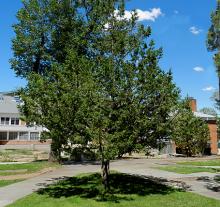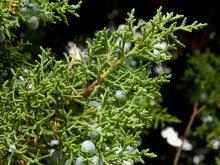Juniperus osteosperma
Common name:
Utah Juniper
Pronunciation:
ju-NIP-er-us oss-tee-oh-SPUR-ma
Family:
Cupressaceae
Genus:
Type:
Conifer
Native to (or naturalized in) Oregon:
No
- Conifer, evergreen shrub or short trunked tree, 15-30 ft (4.5-9 m) tall, crowns rounded and full. Branches spreading to ascending. Branchlets erect, 3 or 4-sided in cross section. Leaves scale-like light yellow-green, each only 1-2 mm, usually not overlapping, keeled, apex rounded, acute or occasionally obtuse, appressed. Seed cones maturing in 1-2 years, globose, mostly 6-9 mm, bluish brown, often almost tan beneath glaucous coating, fibrous, with 1 (or 2) seeds, each 4-5 mm.
- Sun to light shade, well-drainged soil
- Hardy to USDA Zone 3 The most common tree in the Great Basin and is widely distributed throughout the arid West. It occasionally occurs in southern Idaho, southern Montana, and western Wyoming, and is common in Colorado, Utah, Nevada, New Mexico, Arizona, and southeastern California; usually found on dry, rocky soil and slopes. The dominant juniper in Utah and possibly Arizona.
- osteosperma: from osteon, bony, and sperma, seed or germ, a bony or hard seed.







